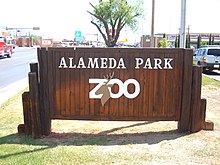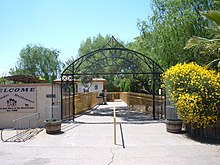Alameda Park Zoo

Zoo sign on White Sands Blvd
|
|

Entrance gate and entrance bridge over the duck pond
|
|
| Date opened | 1898 |
|---|---|
| Location | White Sands Blvd at 10th Street, Alamogordo, New Mexico United States |
| Coordinates | 32°54′05″N 105°57′40″W / 32.9015°N 105.9610°WCoordinates: 32°54′05″N 105°57′40″W / 32.9015°N 105.9610°W |
| Land area | 13 acres (5.3 ha) |
| Number of animals | 265 |
| Number of species | 90 |
| Annual visitors | 60,000 |
| Memberships | AZA |
| Website | ci |
Alameda Park Zoo, located in Alamogordo, New Mexico, was founded in 1898 and claims to be the oldest zoo in the Southwestern United States. It is one of three AZA-accredited zoos in New Mexico and participates in the Species Survival Plan for the Mexican wolf.
Notable species at the zoo include the White Sands pupfish, the Mexican wolf, the Hawaiian goose, and the markhor goat.
The zoo is a Species Survival Plan Captive Facility for the Mexican gray wolf, and in 2006 there were two wolves resident in the zoo. Three Mexican gray wolf pups were born at the zoo in 1994, and seven in 1995.
The zoo receives birds of prey that have been injured and heals them. If the birds are well enough to return to the wild they are released, otherwise they are kept in the zoo.
Some special exhibits include a lemur exhibit, a birds of prey exhibit, and a butterfly garden.
Several programs operate in the Educational Center, including an Eco-Ranger Junior Zookeeper program. The center is also open to the public for viewing videos and reading books from the collection. Some animals are housed in the center.
Alameda Park Zoo is accredited through March 2011 by Association of Zoos and Aquariums. It is one of about 220 zoos to hold AZA accreditation, and one of only three in New Mexico (the other two are Albuquerque Biological Park and Living Desert Zoo and Gardens State Park in Carlsbad).
The zoo was created in 1898 at its present location at the south end of Alameda Park to entertain train passengers while they waited for the train to refuel. In the early days the zoo received gifts of exotic pets such as raccoons, skunks and birds from local residents. Cages in the early days were made of chain-link fencing, and these were gradually replaced beginning in the 1970s and 1980s. The zoo went into decline in the 1970s, and in an 1987 interview the zoo director said that in the mid-70s "the zoo was a dilapidated menagerie". The zoo had become a hangout for loiterers and drug dealers, and the city was faced with a decision to either shut down the zoo or upgrade it. They chose to upgrade, and a perimeter fence was added in 1986 to control access.
...
Wikipedia
